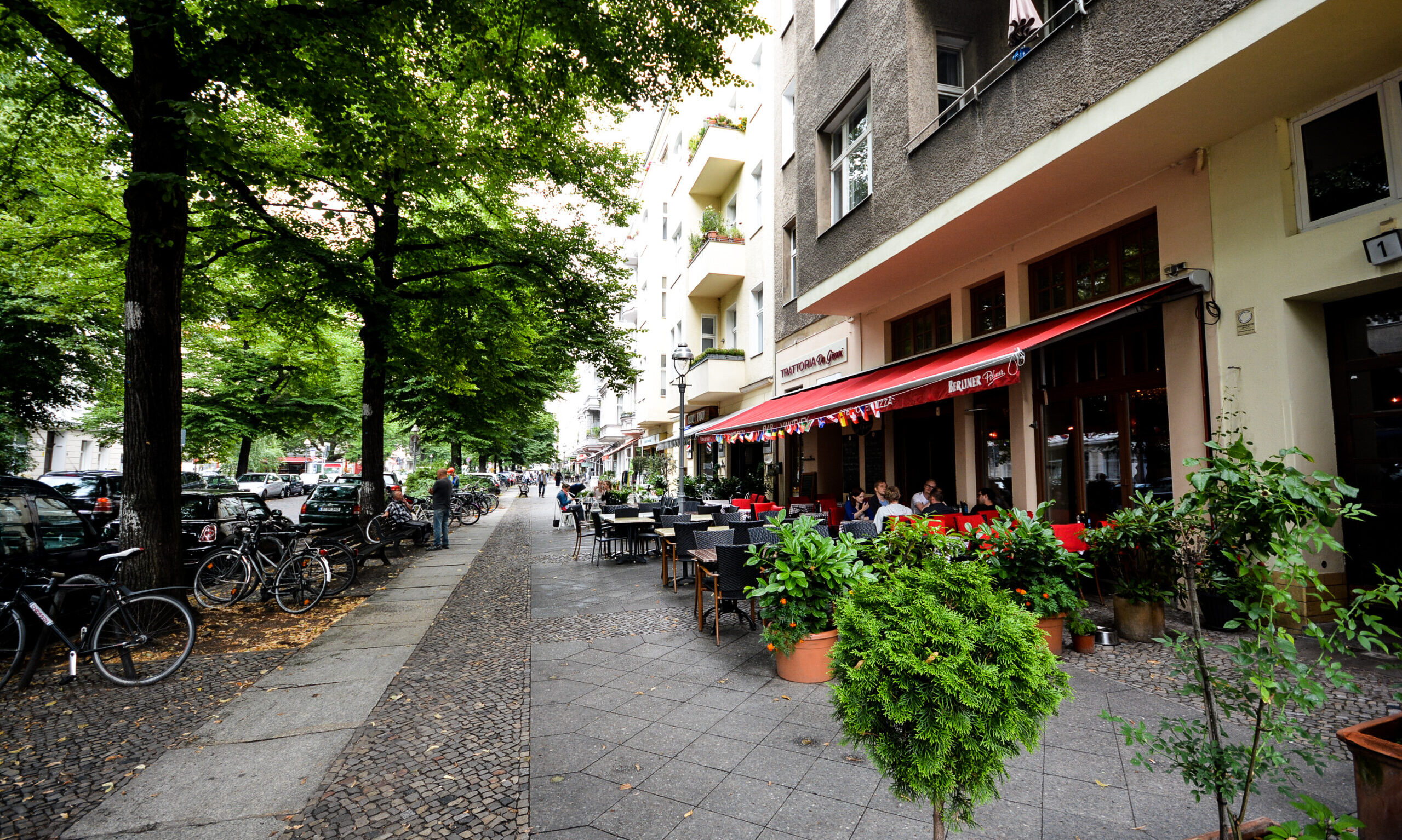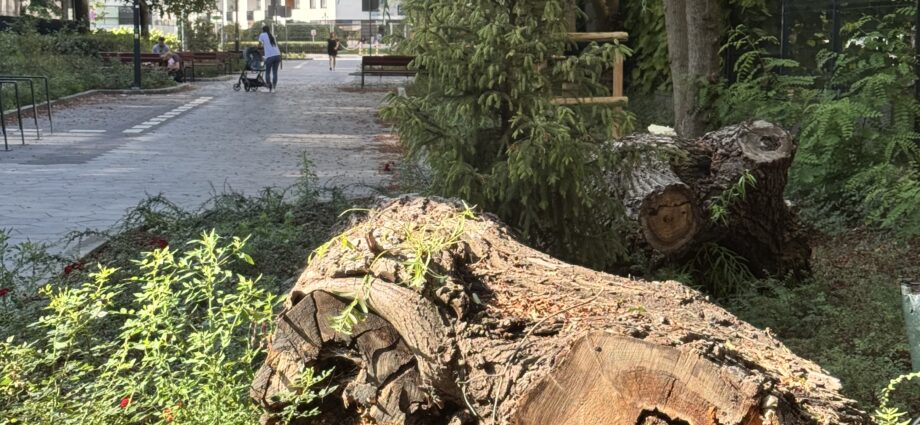By Savannah Siekierski
Savannah is currently doing her Master’s level internship at Pedestrian Space. As part of her internship with us, she is crafting ‘notes from the field’ from her research to share here. This is the first in a series of media field notes she is producing related to her research.
“In such a rapidly changing and densifying area, even small pockets of space that prioritize people, children, and slow mobility can make a noticeable difference in everyday life.“
Three weeks ago, at the end of August, I packed up my life and moved from Brussels to Warsaw. During the long drive, I listened to the August episode of the podcast Miasto Jest Nasze, which discussed the creation of the new woonerf in Warsaw’s Żoliborz district and the hopes and concerns surrounding it. The story intrigued me with its unusual development: the residents advocated for a fully pedestrian zone, collecting over 1,000 signatures. But since the local development plan by the developer had designated the street to be open to traffic, the final outcome was something neither here nor there — a woonerf, Dutch for a “living street”, prioritizing pedestrian use, yet still allowing cars to park and pass at 20km/h. I decided that, as soon as I settled back in, I would visit the area to see this compromise for myself.
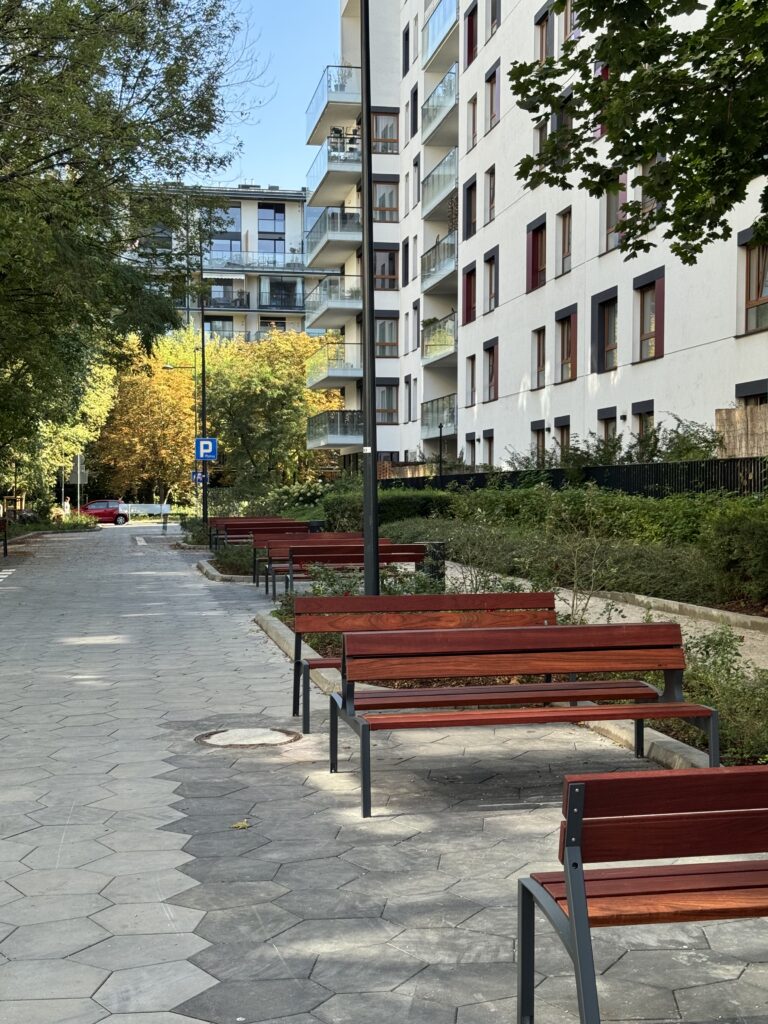
I arrived at Brandysa Street on a warm Friday morning, around 11 am. Entering from Zygmunta Hübnera Street, I passed a provisional fence closing the street off from car traffic for the time being. As I entered, the area appeared calm and quiet, but not completely empty. I noticed the unique geometry, with rows of benches lining the street, as well as plenty of bike racks, though none were in use at that time. Among some older trees, fortunately preserved during the street construction thanks to the active engagement of the local representatives, there are also some newly planted ones, while the logs from a tree that collapsed during the works are used as decoration and left to decompose naturally on the side.
“What struck me was how, in this (temporary) absence of cars, people felt confident walking down the middle of the street, at ease, taking their time, pausing.”
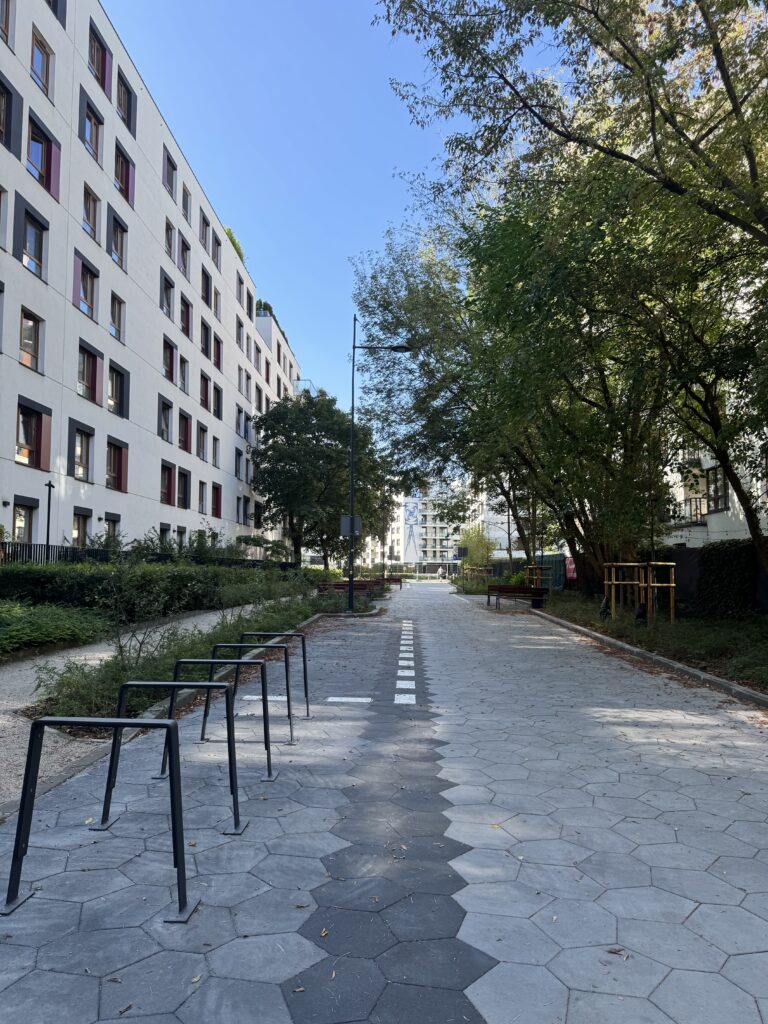
During my time there, I saw multiple people passing by, relaxed, unhurried, occasionally using the benches to take a phone call or tie a child’s shoe. What struck me was how, in this (temporary) absence of cars, people felt confident walking down the middle of the street, at ease, taking their time, pausing. I decided to talk to two women appearing to be in their 70s and walking down the street in my direction. When I asked them what they think about this space, they focused mainly on its functionality, describing it as “a street for people” and explaining how important it is that children from the nearby nursery and kindergarten, neither of which has their own playgrounds, could cross through here safely on their way to the nearby parks and play areas. As residents of the neighbourhood, their views focused less on whether the design was creative or attractive, and more on its everyday usefulness and safety. After this brief exchange, I stayed around to observe a bit longer — a young man sitting on one of the benches and taking a phone call, several women strolling with prams, and another woman walking down the street carrying her bags.
“I will need to return once the barriers are removed, to see whether the area continues to function as “a street for people”, and whether it can serve as a model for the new developments in South Żoliborz.“
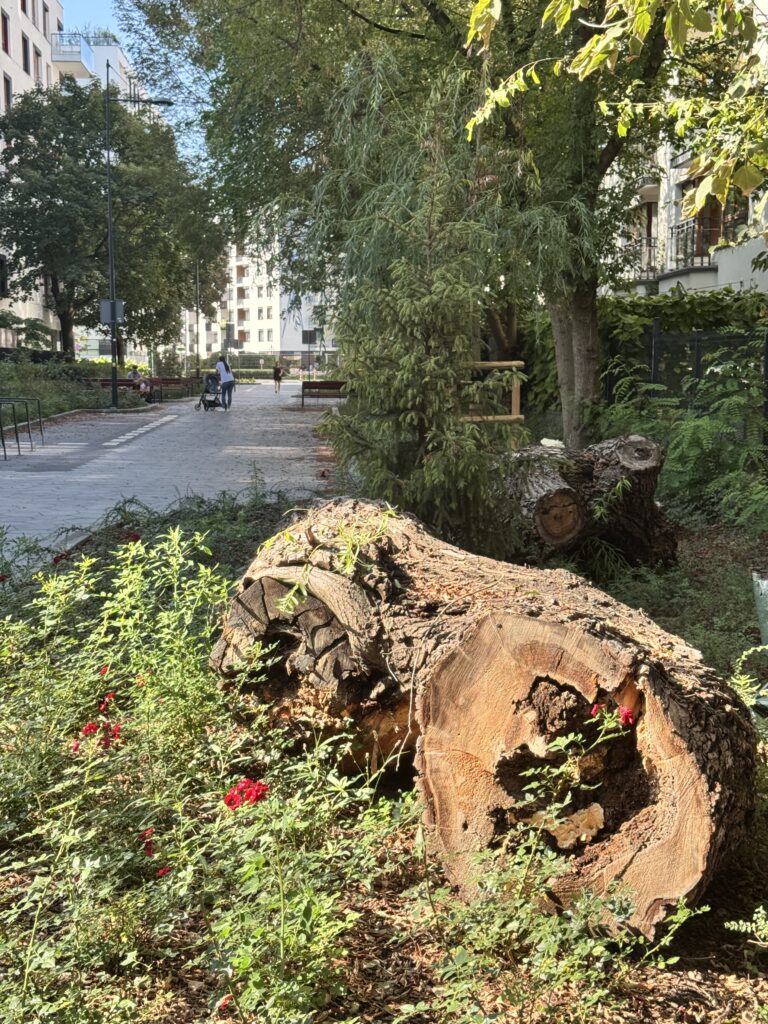
For now, before the cars are allowed to park and pass through, the space feels calm and people-oriented, already playing its role as a woonerf. It’s important to note that we are in a district that has been filling up with dense housing, heavy traffic, and a growing number of residents, children, and cyclists. In such a rapidly changing and densifying area, even small pockets of space that prioritize people, children, and slow mobility can make a noticeable difference in everyday life. But as Żoliborz council member Łukasz Porębski explained in the podcast, the woonerf is still an experiment, and we will have to wait until cars are allowed inside to see how drivers really behave, how deliveries and services are managed, and whether pedestrians continue to feel as comfortable and confident using the street as they do now. I left Brandysa Street with the same thought: I will need to return once the barriers are removed, to see whether the area continues to function as “a street for people”, and whether it can serve as a model for the new developments in South Żoliborz.
“As residents of the neighbourhood, their views focused less on whether the design was creative or attractive, and more on its everyday usefulness and safety.“
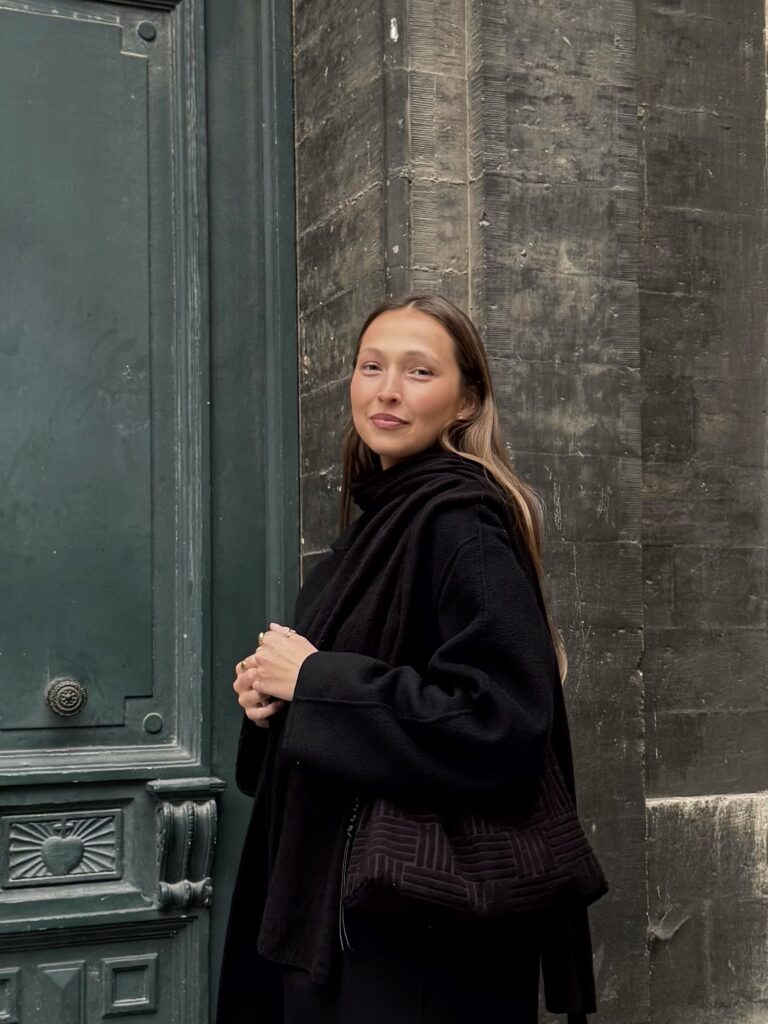
Savannah Siekierski is a Master’s student in Urban Studies at ULB/VUB in Brussels, while also holding previous bachelor’s and master’s degrees in Psychology and Cognitive Neuroscience. She is particularly interested in bridging these fields with urbanism to explore how people feel, perceive, and connect to their environments. Her research focuses on the subjective and sensory experience of urban space, with a special emphasis on walking as an embodied practice. Savannah joined Pedestrian Space as an intern to align her academic interests in the psychology of urban experience with the organization’s focus on participatory advocacy and resident-centered urban perspectives. During her internship, she is pursuing research in Warsaw through methods such as auto-ethnography and walking interviews. Alongside her fieldwork, she is also contributing a media diary reflecting on her process and offering insights into walkability and urban life.
Sources:
Miasto Jest Nasze. (2025, August 12). #WarszawskieTętno: Jak będzie na woonerfie oraz dlaczego Warszawa nie śpi? [Podcast]. Retrieved September 20, 2025, from https://miastojestnasze.org/podcast/
Naszemiasto.pl. (2025, July,14). Pierwsza taka ulica na Żoliborzu powstała z myślą o pieszych i zieleni – wyjątkowa inwestycja w skali miasta. Retrieved September 20, 2025, from https://warszawa.naszemiasto.pl/pierwsza-taka ulica-na-zoliborzu-powstala-z-mysla-o-pieszych-i-zieleni-wyjatkowa-inwestycja-w-skali-miasta/ar/ c1p2-27728965
wyborcza.pl (2025, August 4). Pierwszy woonerf na Żoliborzu zachwyca i budzi trwogę. Retrieved September 20, 2025. Warszawa, 2025, from https://warszawa.wyborcza.pl/warszawa/7,54420,32152220,pierwszy woonerf-na-zoliborzu-zachwyca-i-budzi-trwoge-wstawiliscie.html
